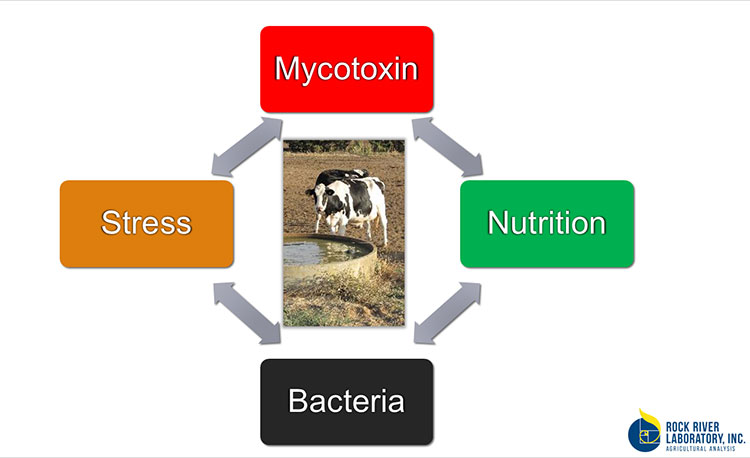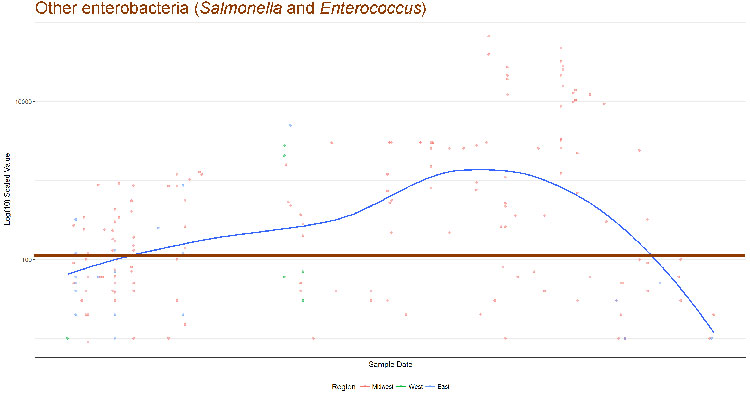
Performance variations observed
“Based on recent support call frequency, many within the dairy industry are not recognizing optimal performance,” explains John Goeser, animal nutrition, research and innovation director for Rock River Laboratory. “Many dairy farms seem to be enduring more variation in health, reproductive performance, nutrient digestion and overall dairy performance.”
Causative factors
Historically, mold, yeast, and toxin counts have been the industry’s focus when evaluating anti-nutrition factors. “Wild yeast has been shown to negatively affect the rumen’s ability to metabolize nutrients,” states Goeser (Santos et al., 2015). “While mycotoxins are understood to affect reproductive performance, suppress the immune system, affect the central nervous system, and damage the liver, kidneys, and gut tissue.” Goeser concludes there are always multiple mycotoxins present, and sometimes they will act synergistically, “similar to being kicked in the shin and the backside at the same time.”


Clostridium and E. coli have been implicated in hemorrhagic bowel cases (Dennison et al., 2002; Baines et al., 2011), while Salmonella can severely affect the nervous system (McGuirk and Peek, 2003). These bacteria are increasingly identified as the industry strives to fine tune animal nutrition programs. Figures 2 and 3 demonstrate recent laboratory measures for enterobacteria in total mixed rations (TMRs) and individual feeds (Rock River Laboratory data, 2016). Many samples are beyond the 100-colony forming unit per gram (CFU / g) concern levels, indicating the potential for challenges if other toxins or stressors are also affecting animal health.
Opportunities to defend and combat
While these cases of multiple factors working negatively within the animal can be grim, there are opportunities to defend production and combat these factors. “If dairy or feedlot health has been challenged with symptoms similar to those discussed and performance is less than expected, consider evaluating bacterial contamination in addition to mold, yeast and mycotoxin concentrations,” recommends Goeser. “Work to minimize bacterial contamination by keeping equipment and bunks clean and limiting soil contamination.” He also suggests consulting with trusted veterinary and nutrition advisory teammates, understanding that several factors can unfortunately synergistically work against animal health and performance (as diagramed in Figure 1.)
From a nutrition standpoint, dairy producers and their consultants should work to minimize starch entering the intestine and hind-gut. “Excess starch can create favorable gut conditions for mold and bacterial infestation,” describes Goeser. “Producers should consider evaluating TMR rumen in situ starch digestion to determine if excess starch is passing the rumen [in situ rumen starch digestion less than 65 percent of total starch].”
As the winter brings challenges of its own for Midwest producers, it’s still important to monitor all aspects of the daily dairy cow’s routine to proactively mitigate risks, or combat those challenges if they do spawn into bigger concerns with negative results. As anti-nutritional factors continue to threaten dairy productivity and health, adhering to observation, analysis, research and advisor’s recommendations could be the best Christmas present you give your or your clients’ cattle.
Founded in 1976, Rock River Laboratory is a family-owned laboratory network that provides production assistance to the agricultural industry through the use of advanced diagnostic systems, progressive techniques, and research-supported analyses. Employing a team of top specialists in their respective fields, Rock River Laboratory provides accurate, cost-effective, and timely analytical results to customers worldwide, while featuring unsurpassed customer service.

